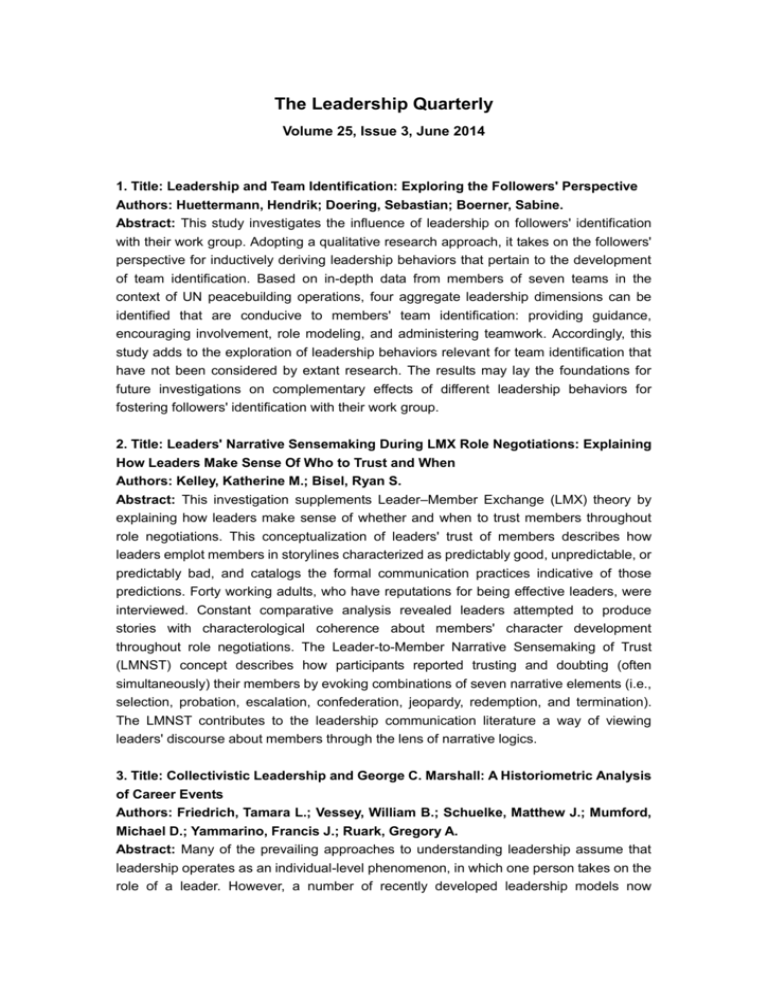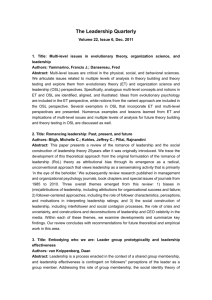The Leadership Quarterly Volume 25, Issue 3, June 2014 1. Title
advertisement

The Leadership Quarterly Volume 25, Issue 3, June 2014 1. Title: Leadership and Team Identification: Exploring the Followers' Perspective Authors: Huettermann, Hendrik; Doering, Sebastian; Boerner, Sabine. Abstract: This study investigates the influence of leadership on followers' identification with their work group. Adopting a qualitative research approach, it takes on the followers' perspective for inductively deriving leadership behaviors that pertain to the development of team identification. Based on in-depth data from members of seven teams in the context of UN peacebuilding operations, four aggregate leadership dimensions can be identified that are conducive to members' team identification: providing guidance, encouraging involvement, role modeling, and administering teamwork. Accordingly, this study adds to the exploration of leadership behaviors relevant for team identification that have not been considered by extant research. The results may lay the foundations for future investigations on complementary effects of different leadership behaviors for fostering followers' identification with their work group. 2. Title: Leaders' Narrative Sensemaking During LMX Role Negotiations: Explaining How Leaders Make Sense Of Who to Trust and When Authors: Kelley, Katherine M.; Bisel, Ryan S. Abstract: This investigation supplements Leader–Member Exchange (LMX) theory by explaining how leaders make sense of whether and when to trust members throughout role negotiations. This conceptualization of leaders' trust of members describes how leaders emplot members in storylines characterized as predictably good, unpredictable, or predictably bad, and catalogs the formal communication practices indicative of those predictions. Forty working adults, who have reputations for being effective leaders, were interviewed. Constant comparative analysis revealed leaders attempted to produce stories with characterological coherence about members' character development throughout role negotiations. The Leader-to-Member Narrative Sensemaking of Trust (LMNST) concept describes how participants reported trusting and doubting (often simultaneously) their members by evoking combinations of seven narrative elements (i.e., selection, probation, escalation, confederation, jeopardy, redemption, and termination). The LMNST contributes to the leadership communication literature a way of viewing leaders' discourse about members through the lens of narrative logics. 3. Title: Collectivistic Leadership and George C. Marshall: A Historiometric Analysis of Career Events Authors: Friedrich, Tamara L.; Vessey, William B.; Schuelke, Matthew J.; Mumford, Michael D.; Yammarino, Francis J.; Ruark, Gregory A. Abstract: Many of the prevailing approaches to understanding leadership assume that leadership operates as an individual-level phenomenon, in which one person takes on the role of a leader. However, a number of recently developed leadership models now describe leadership as a shared process. These collectivistic theories present leadership as a dynamic process in which a leader may selectively utilize the skills of followers and distribute elements of the leadership role among these followers as the situation demands. In this study, we conduct an investigation into the viability of core elements of the collectivistic theories through a historiometric analysis of events from the career of a notable leader, George C. Marshall. One hundred and two events from Marshall's career were identified from historical biographies and were then content coded and analyzed with regard to the components of a collectivistic leadership model. The results of this historiometric analysis indicated that there are key antecedents to collectivistic leadership and that the use of this form of leadership can result in positive team outcomes. 4. Title: Social Identity Framing Communication Strategies for Mobilizing Social Change Authors: Seyranian, Viviane. Abstract: Social identity framing delineates a set of communication tactics that leaders may use to harness follower support for a vision of social change. An experimental design tested the effectiveness of three social identity framing communication tactics (inclusive language, similarity language, positive social identity language) on follower outcomes. Students (N =246) completed dependent measures after reading one of eight possible leader speeches promoting renewable energy on campus. Results showed that participants exposed to inclusive language were more likely to: indicate that renewable energy was ingroup normative; intend to engage in collective action to bring renewable energy to campus; experience positive emotions and confidence about change; and to view the leader more positively. The combination of inclusive language and positive social identity increased ratings of leader charisma. Perceived leader prototypicality was related to followers' social identification, environmental values, ingroup injunctive norms, and self-stereotypes. Positive social identity language increased collective self-esteem. These results underline the important role of implicating social identity in leader communication that strives to mobilize follower support for social change. 5. Title: Empowering Leadership: Construct Clarification, Conceptualization, and Validation of a New Scale Authors: Amundsen, Stein; Martinsen, Øyvind L. Abstract: In this paper we discuss key aspects of empowering leadership as a basis for conceptualizing and operationalizing the construct. The conceptualization resulted in eight behavioral manifestations arranged within three influence processes, which were investigated in a sample of 317 subordinates in Study 1. The results supported the validity and reliability of a two-dimensional, 18-item instrument, labeled the Empowering Leadership Scale (ELS). In Study 2 (N =215) and Study 3 (N =831) the factor structure of ELS was cross-validated in two independent samples from different work settings. Preliminary concurrent validation in Studies 1 and 2 found that ELS had a positive relationship to several subordinate variables, among others self-leadership and psychological empowerment. In Study 3 ELS was compared with scales measuring leader–member exchange (LMX) and transformational leadership. Discriminant validity was supported, and moreover, ELS showed incremental validity beyond LMX and transformational leadership when predicting psychological empowerment. 6. Title: Leaders' and Subordinates' Attachment Orientations, Emotion Regulation Capabilities and Affect At Work: A Multilevel Analysis Authors: Kafetsios, Konstantinos; Athanasiadou, Maria; Dimou, Nafsika. Abstract: Two studies examined relationships between leaders' and subordinates' attachment orientations, emotion regulation capabilities, and affective experience and satisfaction at work. As expected, supervisors' and subordinates' insecure attachment orientations (higher anxiety and avoidance) were associated with own positive affect and satisfaction at work. Supervisors' anxious attachment orientation was associated with subordinates' lower positive affect and satisfaction at work. Contrary to hypotheses, supervisors' higher avoidance was associated with subordinates' lower negative affect and higher job satisfaction. Supervisors' emotion regulation capabilities did not mediate relationships between supervisors' insecure attachment orientations and supervisors' own or subordinates' affect and job satisfaction as expected. However, subordinates' emotion regulation capabilities interacted with supervisors' attachment orientations to predict subordinates' emotion experience at work. The results contribute to an understanding of attachment orientations' emotion dynamics in leader–follower interaction, pointing in particular to perceptual and affect-related processes at different levels of analysis. 7. Title: The Impact of Ethical Leadership Within yhe Recruitment Context: The Roles of Organizational Reputation, Applicant Personality, and Value Congruence Authors: Ogunfowora, Babatunde. Abstract: The present research examined the effects of corporate executive officer (CEO) ethical leadership on the job pursuit attitudes and behaviors of prospective job applicants. Furthermore, this paper tested two potential mediatory mechanisms for explaining why CEO ethicality matters to prospective applicants: perceived organizational reputation (Study 1) and perceived value congruence with the CEO or person–CEO fit (Study 2). The results of Study 1 showed that job seekers at a career fair were more likely to apply for a job with an ethical CEO's company, compared to that of a morally-questionable CEO or one whose ethicality was unknown. The results also showed that perceived organizational reputation mediated the relationship between CEO ethicality and job pursuit. These findings were replicated in Study 2. In addition, Study 2 showed that perceived value congruence with the CEO also mediated the link between CEO ethicality and job pursuit, although this effect was conditional on the Honesty–Humility personality of the prospective job applicant. These findings highlight the potential relevance of executive ethical leadership within the recruitment context. 8. Title: Same Difference? Exploring the Differential Mechanisms Linking Servant Leadership and Transformational Leadership to Follower Outcomes Authors: van Dierendonck, Dirk; Stam, Daan; Boersma, Pieter; de Windt, Ninotchka; Alkema, Jorrit. Abstract: This paper aimed to provide insights into the different mediating mechanisms through which servant leadership (SL) and transformational leadership (TFL) affect followers. We also investigated environmental uncertainty as a moderator of the effects of servant leadership and transformational leadership. Based on the results of two experimental studies and one field study, we concluded that both SL and TFL were related to organizational commitment and work engagement; however, the manner in which they exerted their influence differed. SL worked primarily through follower need satisfaction, whereas TFL worked mainly through perceived leadership effectiveness. The moderating influence of uncertainty was inconsistent across the studies. 9. Title: The Role of Organizational Leaders in Employee Emotion Management: A Theoretical Model Authors: Kaplan, Seth; Cortina, Jose; Ruark, Gregory; LaPort, Kate; Nicolaides, Vias. Abstract: The actions of organizational leaders are important determinants of the emergence, management, and consequences of employee emotional experience. However, the nature and dimensionality of leader emotion management and the behaviors that constitute such management are largely unknown. The authors present a comprehensive, theoretically-derived model of leader emotion management which clarifies the nature of emotion management and its role in leadership. This model also delineates the knowledge and skill-based antecedents of emotion management and the consequences of such management. Specifically, we propose linkages between particular KSAOs and specific emotion management dimensions and between those dimensions and particular individual and organizational outcomes. The model is meant to serve as a framework to guide empirical efforts in investigating the nature and correlates of leader emotion management. 10. Title: The Effects of Authentic Leadership on Followers' Ethical Decision-Making in the Face of Temptation: An Experimental Study Authors: Cianci, Anna M.; Hannah, Sean T.; Roberts, Ross P.; Tsakumis, George T. Abstract: The present research investigates the impact of authentic leadership on followers' morality, operationalized as ethical decision-making, in the face of temptation. This experiment finds that authentic leadership and temptation interacted to affect individuals' ethical decision-making. Specifically, authentic leadership significantly inhibited individuals' from making unethical decisions in the face of temptation, whereas followers of neutral or less authentic leaders were more likely to succumb to temptation. Authentic leadership did not have a significant impact on ethical decision-making when temptation was absent. Further, results showed a significant moderated-mediated effect whereby the interactive effect of authentic leadership and temptation on individuals' guilt appraisal was mediated through the nature of the ethical decision. Theoretical and practical implications of these findings are discussed. 11. Title: Leader and Follower Attachment Styles: Implications for Authentic Leader–Follower Relationships Authors: Hinojosa, Amanda S.; Davis McCauley, Kelly; Randolph-Seng, Brandon; Gardner, William L. Abstract: Authentic leadership theory posits that the authenticity of leaders and followers is influenced by their personal histories. Attachment theory states that individuals have internal working models that are influenced by both early developmental experiences and relationships later in life. These models guide how people interact with close others and tend toward three styles of attachment: secure, insecure-ambivalent, and insecure-avoidant. We argue that securely attached persons are most likely to exhibit authentic leadership/followership. We review empirical work which suggests that secure attachment is positively related to each of the four components of authentic leadership/followership (self-awareness, relational transparency, balanced processing, and internalized moral perspective). We then develop an attachment-based typology for variations in authentic leader–follower relationships, with emphasis on relationships that include an insecurely attached party. Finally, we draw from the attachment and authentic leadership literatures to suggest interventions to foster the development of authentic leadership/followership, thereby enhancing authentic leader–follower relationships. 12. Title: Beyond Leader–Member Exchange (LMX) Differentiation: An Indigenous Approach to Leader–Member Relationship Differentiation Authors: Chen, Ying; Yu, Enhai; Son, Jooyeon. Abstract: The existing literature has established that leaders differentiate among their followers; however, the focus has long been on the Western leader–member exchange (LMX) theory. This paper examines leader–member relationship differentiation from an indigenous, leader–member guanxi (LMG) perspective. Using a sample of 60 groups and 228 employees, we examined the dual effects of LMG differentiation on employee job satisfaction, organizational commitment, turnover intention, and co-worker helping behavior after controlling for LMX, LMX median, and LMX differentiation. The results of this study supported the proposed dual effects of LMG differentiation, demonstrating that LMG differentiation, in general, is detrimental to employees' work attitudes and their intentions to stay in an organization. On the contrary, interestingly enough, LMG differentiation can accentuate the positive relationship between LMG and job satisfaction, organizational commitment, and co-worker helping behaviors.







